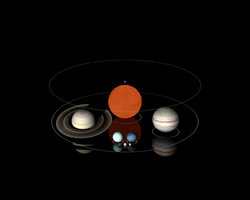OGLE-TR-122
| Observation data EpochJ2000.0EquinoxJ2000.0(ICRS) | |
|---|---|
| Constellation | Carina |
| Right ascension | 11h06m51.99s[1] |
| Declination | −60° 51′ 45.7″[1] |
| Characteristics | |
| Spectral type | ?(primary)/M (b)[2] |
| Apparent magnitude(I) | 15.61 (system)[1] |
| Variable type | Eclipsing binary |
| Orbit[2] | |
| Period(P) | 7.26867d |
| Eccentricity(e) | 0.205 ± 0.008 |
| Inclination(i) | 88–90° |
| Periastronepoch(T) | JD2452342.41 ± 0.02 |
| Argument of periastron(ω) (secondary) | 99.2 ± 0.8° |
| Semi-amplitude(K1) (primary) | 9.642 ± 0.088 km/s |
| Details[2] | |
| OGLE-TR-122A | |
| Mass | 0.98 ± 0.14M☉ |
| Radius | 1.05+0.20 −0.09R☉ |
| Surface gravity(logg) | 3.9 ± 0.5cgs |
| Temperature | 5700 ± 300K |
| Metallicity[Fe/H] | 0.15 ± 0.36dex |
| Rotational velocity(vsini) | 5.7 ± 0.6 km/s |
| OGLE-TR-122B | |
| Mass | 0.092 ± 0.009M☉ |
| Radius | 0.120+0.024 −0.013R☉ |
| Other designations | |
V817Car | |
| Database references | |
| SIMBAD | data |
OGLE-TR-122is abinarystellar systemcontaining one of the smallestmain-sequencestarswhoseradiushas been measured. It was discovered when theOptical Gravitational Lensing Experiment(OGLE) survey observed the smaller star eclipsing the larger primary. The orbital period is approximately 7.3 days. The system's primary is thought to resemble theSun.[2]
OGLE-TR-122B
[edit]The smaller star,OGLE-TR-122B,is estimated to have aradiusaround 0.12solar radii,or around 20% larger thanJupiter's, and amassof around 0.1solar masses,or approximately 100 times Jupiter's. This makes its averagedensityapproximately 50 times the Sun's[2][3]or over 80 times the density ofwater.OGLE-TR-122b's mass is close to the lowest possible mass for ahydrogen-fusing star, estimated to be around 0.07 or 0.08 solar masses.[4]The observed transit provides the first direct evidence for a star with a radius comparable to Jupiter's.[2]
-
Brightness «Dip» and Velocity Variations of OGLE-TR-122.
See also
[edit]References
[edit]- ^abcThe Optical Gravitational Lensing Experiment. Additional Planetary and Low-Luminosity Object Transits from the OGLE 2001 and 2002 Observational Campaigns,A. Udalski, G. Pietrzynski, M. Szymanski, M. Kubiak, K. Zebrun, I. Soszynski, O. Szewczyk, and L. Wyrzykowski,Acta Astronomica53(June 2003), pp. 133–149.
- ^abcdefPont, F.; Melo, C. H. F.; Bouchy, F.; Udry, S.; Queloz, D.; Mayor, M.; Santos, N. C. (2005). "A planet-sized transiting star around OGLE-TR-122".Astronomy and Astrophysics.433(2): L21.arXiv:astro-ph/0501611.Bibcode:2005A&A...433L..21P.doi:10.1051/0004-6361:200500025.S2CID14799999.
- ^Newfound Star Smaller than Some Planets,Robert Roy Britt, space, accessed on line May 16, 2007.
- ^Chabrier, Gilles; Baraffe, Isabelle (2000). "Theory of Low-Mass Stars and Substellar Objects".Annual Review of Astronomy and Astrophysics.38:337–377.arXiv:astro-ph/0006383.Bibcode:2000ARA&A..38..337C.doi:10.1146/annurev.astro.38.1.337.S2CID59325115.


